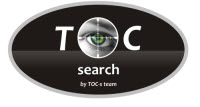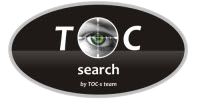About TOC-search?
The scope of the TOC-search data base is to provide in-depth research and analysis on terrorist incidents, terrorist groups, organizations, their members, leaders and also links and relations between the individuals and groups. The idea is to integrate data from variety of sources, including foreign and domestic news, professional security journals, reports and databases, academic works.
The starting point in the TOC-search project was the data presented on the map Al-Qaeda Network: Principals, Supporters, Selected Cells and Significant Activities (1992-2004). The map was prepared by J. L. Boesen, Raytheon Genesis Facility Institute Reston (2004), using the data derived from open sources. The data presented in the map were classified and stored in order to create backbone of the base.
The data in the base are classified in seven entities: individuals, groups, organizations, supporter, actions, links and GMC reports. The simple and advanced search features are implemented in the TOC-s. The simple search enables the researcher to explore the chosen entity by given keyword or part of an entity name. The advances search feature is implemented for each entity. It is performed by using different properties: alias, belongs to organization, belongs to group, leader, religion, in relation with, type or actors of the attack, etc. All search results are presented together with the basic information on the found subjects, enabling in-depth search to be performed as well. An important feature of the TOCs is the fact that links between the mentioned terrorist-related categories are stored and classified in the data base. The results of both simple and advance search provide information whether there is a link (active or inactive) from a particular item. The in-depth search feature gives more information on the found link. This is a unique feature of the TOC-s which no other terrorist database has had up to this point.
One of the key advantages of the TOC-s is the fact that its basic data source is verified information from the reports prepared and provided by George C Marshall European Center for Security Studies http://www.marshallcenter.org. The PTSS Reports are produced by special newsletter service supporting the counterterrorism course at The George C. Marshall European Center for Security Studies, and it is created for educational purposes only. The newsletter is produced from the open-source media reports by GMC postgraduate students and verified by senior experts and counter terrorism officers. This is the main reason why PTSS has been chosen as the main data source for TOC-s. Besides PTSS Reports, GMC also publishes several other reports based on different open source data, such as: Department of Homeland Security Report (DHS), Terrorism Open Source Intelligence Report (TOSIR), Insurgency Literature Review (ILR) and Terrorism Literature Report (TLR).
The incoming reports are sorted and stored by date in GMC section of the TOC-s database. The George Marshall Center provided us with their GMC reports archive and they keep sending us the daily PTSS and other GMC reports In this way, a constant refreshment of the base with up-to-date information has been provided. The TOC-s simple search feature through GMC reports is implemented, which enables the exploration of GMC section by using keywords.
At each moment of using TOC-s, one can immediately start a new search or switch to advanced search tool. While exploring the data base, a researcher usually performs multiple search. In order to help the user of the TOC-s, we have implemented the “select tool”. This tool enables the user to put all the important results obtained from different search. In this way, all the data that are essential in the research are available during the further TOC-s exploration. The data in the “selection” tool are easily added or removed. By using option “Feedback” the user may send a message on TOC-s administrator on different topics (site bugs, error data, comments, suggestions, etc. )
The information in the TOC-s database has been constantly updated from the GMC reports and other publicly available, open-source materials. These include electronic news archives, existing data sets, secondary source materials such as books and journals, and legal documents. TOCs team performs constant verification of the data by comparing it with other sources and by internal checking of the data and related records.
It is also important to provide the protection of data stored in the base. In this scope, two levels of data access are implemented in the TOC-s. The first level is named “blue key” and it is available for students and researchers in academic institutions and research centers. The “blue key” enables the access to all open-source data stored in the base. The second level of data access, named “red key” is reserved for legal authorities, state institutions, and state government. The “red key” opens the part of the TOC-s with confidential data. The owner of the “red key” also has access to the open source data, as the “blue key” owner. Only state institutions and agencies which have a contract with TOC-s have an access to the red key data and they are red key members.
In the next phase of the TOC-s project, several analytical features are to be incorporated in the database. Analytical tools will provide statistical information analysis of the global terrorist network. The researcher will be able to analyze terrorism trends over time and to compare different aspects of terrorism between countries, regions and terrorist groups (for example: type of terrorist attacks, level of organization, tactics, communication level, size of a terrorist group, age or race of its members, and many others). The results of statistical analysis will be presented graphically in various charts, showing the dependencies and/or the comparisons of the chosen aspects. The chart type can also be chosen by the user.
An analytical-purpose system will be used to understand the structure of different terrorist organizations with respect to particular attack types or regions of their activity. By using this system, the intelligence analysts will be able to develop hypotheses and then validate them (or not) against the data in the TOC-s information space. In this way, it will be possible to provide certain predictions of international terrorism trends, seasonality, and periodicity of terrorist events.
In the future phase of the TOC-search project, we also plan to implement the image search feature. This tool will enable to search the image data base for related photographs of individuals or terrorist attacks by using keywords (individual’s name, group/organization name, or the part of the name, specific terrorist incident, date, etc.).
Regarding the practical aspects of the TOC-s database, we emphasize the fact that the TOC-s data were primarily collected by academic groups. This means that TOC-s team was under no political or government pressure in terms of how to collect the data or how to classify them. Although the TOC-s is still in its construction phase, it has already been used in the purpose of Security of the Olympic Games in Beijing 2008, and it is currently being used in the purpose of Security of the World Championship in Football 2010 and World Expo in China 2010.
 Disclaimer
Disclaimer
All information stored in the TOC-search Database is re-taken from different sources. Despite of the fact that every reasonable effort has been made to verify data, TOC Search team cannot guarantee that all information in the database is accurate. TOC-search Team does not hold any Ethical or Legal responsibility for any loss or damage caused by errors or omissions or resulting from any use, misuse, or alteration of TOC-Search data by the user.

